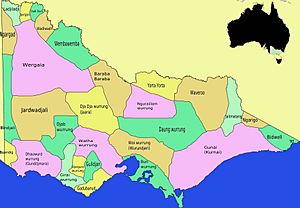Wemba-Wemba facts for kids
The Wemba-Wemba (also called Wamba-Wamba) are an Aboriginal Australian people. They come from north-western Victoria and south-western New South Wales, Australia. This includes areas like the Mallee and the Riverina regions.

Contents
Their Language
The Wemba-Wemba language is very similar to the Woiwurrung language. When Christian missionaries from the Moravian Church came to Wemba-Wemba land, they tried to learn the language. They noticed that the Aboriginal people would sometimes switch to another language. This was because they wanted to keep some things secret from the outsiders.
Their Traditional Lands
Before European settlers arrived in the 1800s, the Wemba-Wemba lived around the Loddon River. Their land stretched north from Kerang, Victoria to Swan Hill. It also included the Avoca River area, going south towards Quambatook.
To the northeast, their territory crossed the border into New South Wales. It reached places like Booroorban and Moulamein, and extended near Barham. In Victoria, Lake Boga and Boort were also part of their lands. Their total land area was about 3,200 square miles (8,300 square kilometers).
How They Lived
The Wemba-Wemba people were made up of five main groups or communities. These groups lived in different areas. Some lived around Towaninny, and another group was near Meelool Station. There was also a group at Lake Boga. A group called the Dietjenbaluk lived at Gonn on the Murray River; their name meant "always on the move." The last group lived at Bael Bael.
Early European Contact
The explorer Thomas Mitchell was the first European to travel through Wemba-Wemba territory. This happened in 1836.
Missionaries and Beliefs
The Wemba-Wemba people had a strong spiritual belief system. They called it yemurraki, which is similar to the idea of Dreaming.
Two German missionaries, Reverend A.F.C. Täger and Reverend F.W. Spieseke, came to the area. They believed the Wemba-Wemba people needed their help. In 1851, they started the Lake Boga mission. However, the mission closed in 1856. This was because not many people joined, and there were disagreements with local officials and landowners. The Moravian Church later started another mission in 1856, called the Ebenezer Mission.

